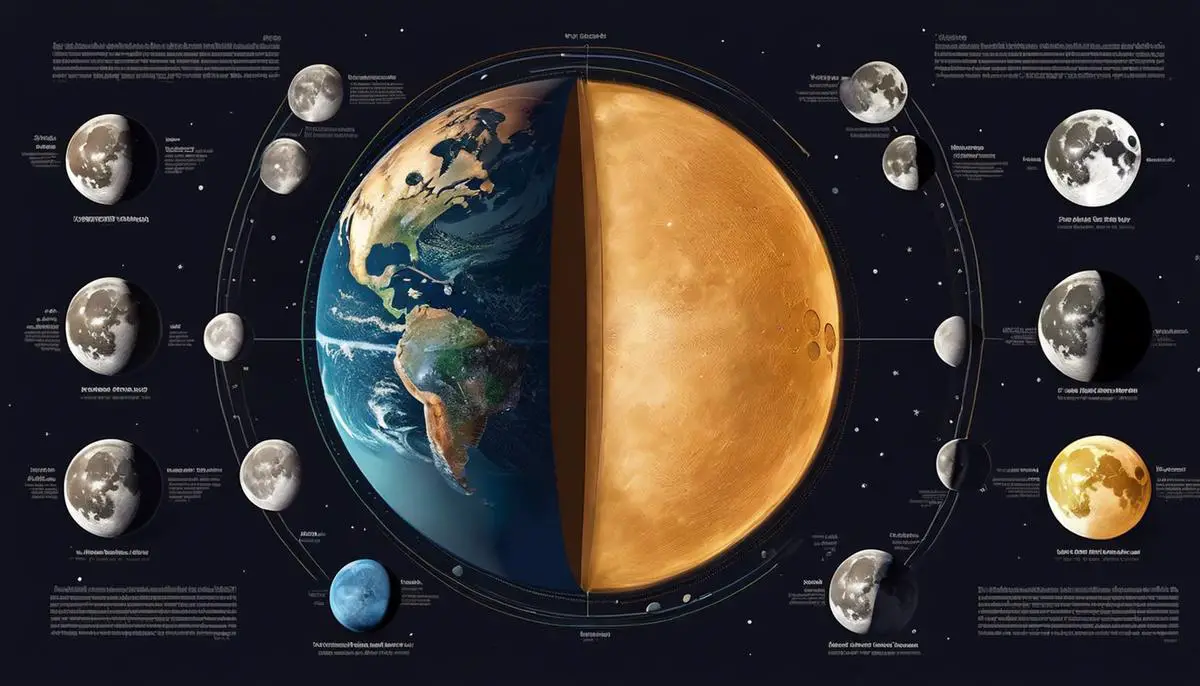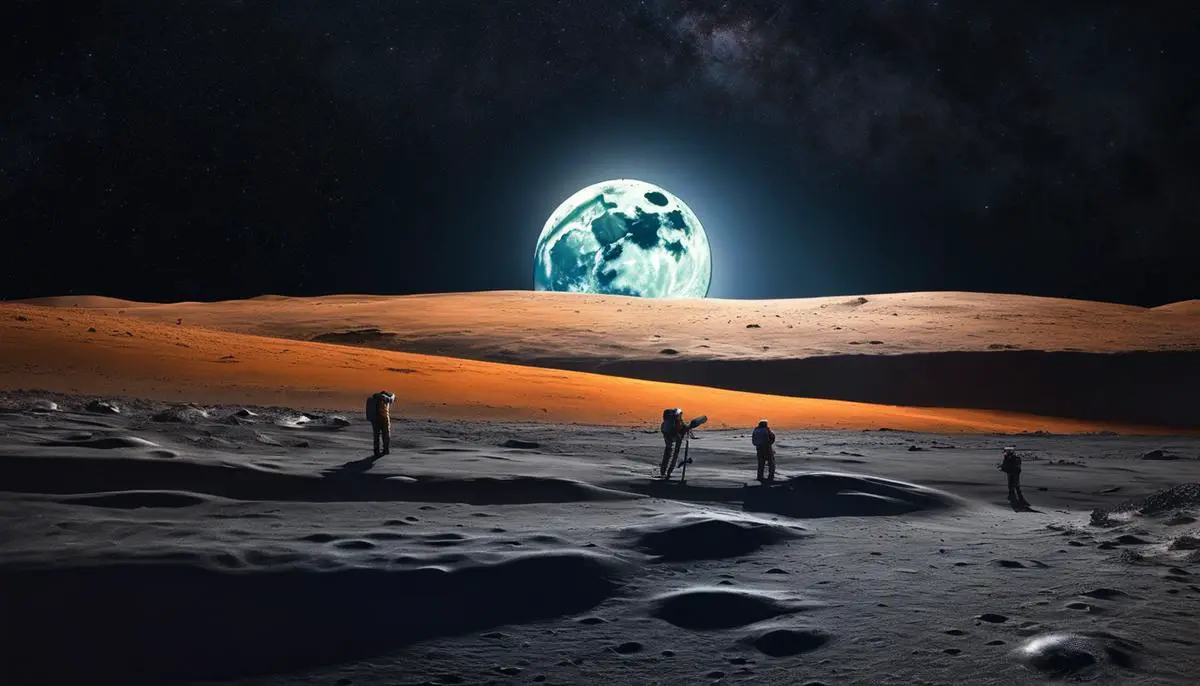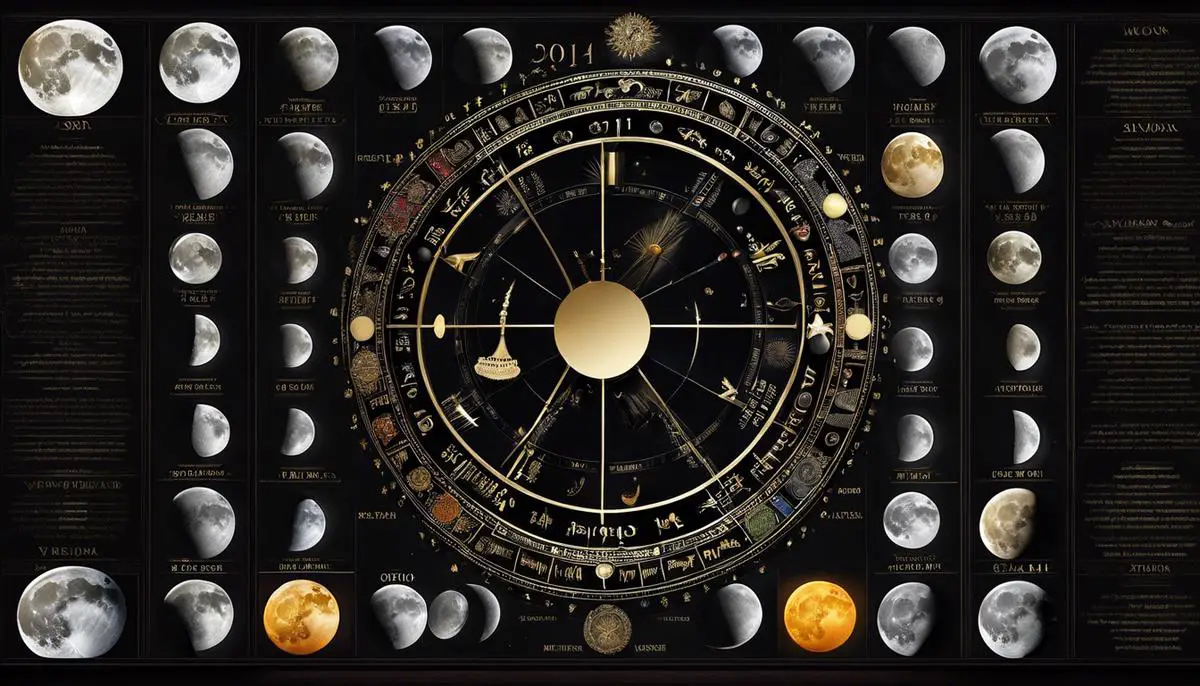The cyclical dance of the moon as it waxes and wanes across the night sky has long enchanted humanity, casting a luminous glow on the tapestry of our collective imagination. The new moon and full moon, each with their distinct presence, have served as the celestial pendulum by which countless generations have measured time, tilled the earth, and woven stories into the fabric of their cultures. As we embark on an explorative journey through the annals of history, our essay delves into the heart of these enduring mysteries and myths. It unearths the myriad ways in which ancient lore has drawn upon the moon’s phases, shaping rituals and beliefs in a world lit by the silver light of our closest celestial neighbor.
Historical Beliefs and Myths about the Moon Phases
Lunar Lore: The Celestial Muse of Myths and Culture
Within the ambit of cultural anthropology and historical mythology, the celestial dynamics of the new moon and full moon have long been a source of profound influence on human societies throughout history. These two phases of the moon, notable for their stark contrast in visibility, have engendered a plethora of beliefs, rituals, and cultural practices that reflect humanity’s innate tendency to seek patterns in the cosmos.
The Mysterious New Moon: A Time for Beginnings and Reflection
Traditionally viewed as a period of rebirth and new beginnings, the new moon has been intimately associated with a symbolic cleansing of the old and the ushering in of the new. In agricultural communities, the dark skies of the new moon signaled a time to rest from planting and tilling, aligning agricultural cycles with lunar patterns. This association can be observed in ancient cultures where lunar deities, such as the Sumerian god Nanna or the Greek goddess Selene, presided over cycles of growth and decay.
Furthermore, the new moon’s invisibility has led to a duality in cultural interpretation—both as an ominous period of caution and a sacred window for introspection. Some historical societies regarded the new moon as a time when evil spirits were afoot, necessitating protective rituals. Contrastingly, others viewed it as a period conducive to divination and spiritual reflection, seizing the opportunity to set intentions for the coming lunar cycle.
The Luminous Full Moon: An Icon of Enlightenment and Celebration
The full moon, by virtue of its completeness and brightness, has garnered a reputation as a time of heightened emotion, enlightenment, and festivity. Myths across various cultures have personified the full moon as an omniscient eye in the night or a benevolent force bestowing fertility and fortune upon the land.
Evocative of its role as a natural illuminator in pre-electric times, the full moon has been a convenient marker for nocturnal activities and communal gatherings. Harvest festivals, such as the Mid-Autumn Festival in East Asia or the European Harvest Moon celebrations, capitalized on the moon’s brilliance to extend the productivity of the day well into the night.
Moreover, the full moon’s prominence in the night sky has not escaped the notice of navigators and explorers, who utilized its light during nocturnal voyages, weaving the lunar cycle into the very fabric of maritime tradition. In literature and poetry, the full moon has often been romanticized as a symbol of eternal love or profound transformation, resonating in countless artistic renditions of lycanthropy and the mesmerizing tales of werewolves or other mystical creatures.
Inextricable Linkages: The Moon’s Gravitas in Culture
Through the lens of historical documentation and the chronicles of oral tradition, it is manifest that the new moon and full moon phases have been intrinsic to the scaffolding of cultural practices over the millennia. From calendars and agriculture to navigation, spirituality, and storytelling, the cyclical nature of the lunar phases has provided a reliable temporal framework that shapes our collective experiences, grounding human history in the celestial waltz of the moon’s eternal dance.
As we continue to unravel the tapestry of human behavior and cultural evolution, the enduring legacy of the moon’s influence serves as a poignant reminder of the interconnectedness between our terrestrial existence and the cosmic phenomena that watch over us from above.

Psychological and Physiological Effects Associated with Moon Phases
The Perceived Influence of Lunar Phases on Human Physiology and Psychology: An Analytical Perspective
The fascination with the celestial bodies, particularly the moon, is deeply rooted in human history, transcending mere observation. Among these, the influence of the moon phases on human behavior has been a subject of contention, clad with anecdotal and cultural underpinnings. This article seeks to dissect the question with a critical lens, evaluating the present-day scientific understanding of any correlation between lunar cycles and human physiology and psychology.
Let us first consider the psychological sphere. Emotion and behavior are complex and multifaceted, influenced by a myriad of factors, both internal and external. The concept that lunar phases, such as the full moon, might exacerbate psychological disturbances or behavior (often referred to colloquially as the “lunacy” effect) has been a topic of great intrigue within psychological research. However, empirical studies conducted within the psychological community have not consistently supported this connection. Meta-analyses examining correlations between the moon’s phases and human behavior routinely fail to reveal a significant linkage. This lack of empirical support suggests that any perceived changes in psychological state during different lunar phases are likely due to socio-cultural expectations or confirmation bias rather than a direct lunar effect.
Turning attention to physiology, within the bounds of chronobiology, the study of periodic phenomena in living organisms and how they adapt to solar and lunar related rhythms, one might hypothesize that if such a profound external influence as the lunar cycle exists, it would manifest within the cyclical nature of human biological processes. An interesting area where science has sought this connection concerns the menstrual cycle, given its roughly lunar month length. Yet, systematic reviews have ascertained that the synchronization between the menstrual and lunar cycles remains anecdotal, contingent upon individual variance and not statistically substantiated in a larger population.
On a related note, sleep patterns could be an area affected by the lunar cycle, given that light plays a cardinal role in circadian rhythms. Research has occasionally reported subtle variations in sleep quality or duration correlated with lunar cycles, particularly around the full moon. These findings, however, are tentative and often originate from studies with limitations in sample size or design, rendering conclusions and generalizations to the broader populace tentative at best.
Furthermore, with regard to physiological domains prone to influence by external geophysical factors, the domain of circulatory health has intrigued researchers. Studies exploring the relationship between the moon’s gravitational pull and incidences of acute events, such as myocardial infarction and stroke, have generally not yielded consistent relationships that withstand rigorous statistical scrutiny.
In light of available evidence, it is thus incumbent upon the academic community to proceed with circumspection, acknowledging that while the moon undoubtedly exerts a gravitational effect on our planet, the breadth of its impact on human physiology and psychology may be considerably overstated in societal lore. Observation, methodological rigor, and replication are the pillars upon which sound conclusions must rest. The persuasiveness of anecdotes and tradition should not eclipse the commitment to empirical evidence and scientific methodology.
In closing, on the subject of lunar influence on humans, contemporary science does not currently provide robust support for significant psychological or physiological effects attributed to lunar phases. Adherence to critical examination and empirical validation remains the cornerstone of further exploration in this enduringly enigmatic domain of lunar-human interactions.

Astrological Theories Related to Lunar Cycles
The Enigmatic Moon: Astrological Theories versus Scientific Scrutiny
The exploration of celestial phenomena has long fascinated humankind, with the moon being a particular object of mystical speculation and scientific inquiry. Views diverge as contemporary astrological theories attribute various influences to the lunar phases, often linking the new moon and full moon to significant changes in human behavior and psychological patterns. This synthesis endeavors to explore such theories within the rigorous landscape of empirical science.
Astrology posits that the new moon, a time obscured by shadow, aligns with personal introspection and the planting of aspirational seeds. Conversely, the full moon is believed to act as a celestial beacon, illuminating hidden truths, and heightened emotional states. Despite the allure of these esoteric assertions, they remain largely unsupported by the bedrock of systematic scientific validation.
In particular, chronobiology—a field that dissects the timing of biological processes—has sought connections between lunar cycles and human physiology. For instance, the oscillation of sleep patterns in concert with the lunar calendar has been the subject of tentatively affirmative findings, suggesting modulated sleep quality or duration around the full moon. However, these conclusions have not coalesced into a consistent theoretical framework, and should thus be met with scholarly skepticism.
Similarly, the interplay between menstrual and lunar cycles is often proposed within astrological circles. However, investigations into this synchronous relationship are plagued by a lack of statistical substantiation. Perhaps even more tenuous are the postulated connections between the lunar cycle and circulatory health, where studies draw on correlational data without establishing causality.
Moreover, selective interpretation of these studies can lead to confirmation bias, underlining the need for cautious scrutiny when examining the assumed effects of the moon on human wellbeing. Successful replication and peer-reviewed corroboration are of paramount importance, given that much of the available literature is inconclusive or methodologically flawed.
In addressing psychological changes linked to lunar cycles, again the evidence remains wanting. Despite the pervasiveness of beliefs in lunar influence—ranging from shifts in mood to erratic behavior during full moons—systematic reviews and meta-analyses conclude there is scant empirical support for these claims. The reiteration of such legends in culture and colloquial dialogue does not equate to scientific endorsement.
In conclusion, while the moon’s influence on Earth is unmistakable—governing tides and possibly affecting some ecological cycles—the attribution of significant psychological or physiological effects to the lunar phases finds no robust support within the scientific community. Cultivating a critical lens and adhering to empirical verification remains essential in further explorations of our interactions with lunar phenomena. Thus, contemporary astrological theories involving the new moon and full moon largely stand as cultural artifacts rather than scientifically substantiated truths. It is through the disciplined construal of evidence that any authentic understanding of lunar influence can emerge.

Lunar Research and Future Frontiers
Innovative Research on Lunar Influence: Unraveling the Moon’s Mysteries
The moon, Earth’s only permanent natural satellite, has captivated scholars and laypersons alike for millennia. Beyond the rich tapestry of cultural and historical significance, it exerts a tangible gravitational effect upon our planet, influencing oceanic tides and ecological systems. In recent years, the scientific community has sought to expound upon these established lunar influences by examining more nuanced interactions between the moon, Earth, and its myriad inhabitants through innovative research methodologies.
Gravitational Pull and Tidal Rhythms
Foremost among these inquiries is the precise quantification of the moon’s gravitational influence on Earth’s bodies of water. Oceanography has entered a renaissance period as technologies like satellite altimetry and buoy-based sensor networks provide high-resolution data streams. These data have furthered understanding of tidal patterns, contributed to refined models for predicting coastal erosion, and illuminated the moon’s role in shaping marine life behaviors through circatidal rhythms.
Lunar Geology and Earth’s Past
Concurrently, lunar geology research is delving into the moon’s surface, seeking insights into Earth’s early history. Missions such as the Lunar Reconnaissance Orbiter are gathering data on lunar surface composition to ascertain historical geophysical processes. By understanding the mutual impacts of Earth and the moon’s formational dynamics, researchers are decoding the archival records of solar system evolution.
Biological Clocks and Lunar Cycles
In the realms of medicine and biology, chronobiology is dissecting potential alignments between biological clocks and lunar cycles. Controlled-environment studies are being employed to isolate organisms from external cues, assessing innate biological rhythms against lunar cycles. Advanced statistical methods are applied to detect subtle patterns in physiological processes, such as cellular cycles, that could be engendered by the moon’s phases.
Astrophysical Interactions and Climate
Astrophysics and climatology have joined forces to postulate and investigate how the moon’s periodic cycle may influence Earth’s climate system. Through the synthesis of century-long climate data and lunar cycle records, scientists probe potential correlations, suggesting that lunar phases may play a role in climate variability on decadal scales.
Advancing Lunar Exploration
Finally, the burgeoning discipline of astrobiology considers the moon as a basis for comparative studies on habitability and life’s resilience. This includes analyzing moon rock samples for signs of water ice and investigating extremophile organisms’ potential to survive in lunar conditions. Through ethical and sophisticated probing of lunar materials, scientists hope to glean broader insights into the possibilities of extraterrestrial life.
Each innovative approach, bolstered by ever-improving technology, strives to contribute a piece to the complex puzzle of lunar influence. The future of this research depends on the meticulous collection of empirical data, the critical examination of hypotheses, and the unfettered quest for knowledge. As such, scientists maintain a judicious balance between open-minded exploration and the rigorous standards of empirical science, ensuring that findings will withstand the scrutiny of the global scientific community and advance a holistic understanding of the moon’s multifaceted impact on Earth’s environment and its denizens.

Through the lens of scientific rigor and the rich palette of historical narrative, our exploration of the relationship between the moon’s phases and the tapestry of human experience has ventured from the shores of ancient myth to the forefront of modern research. The dynamic interplay between the new moon and the full moon continues to resonate, echoing through our collective consciousness, whether reflected in the myths that have survived through time or the innovative studies that pave our way to the stars. As the night sky gifts us with the silent poetry of the moon’s ever-changing face, we find ourselves both humbled and inspired, nestled in the vast cosmos that is both our home and our mystery to unravel.
![]()
